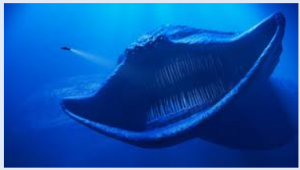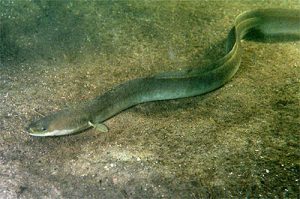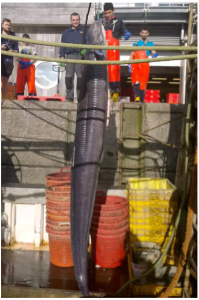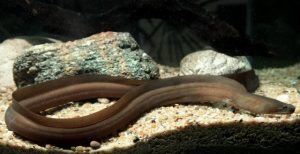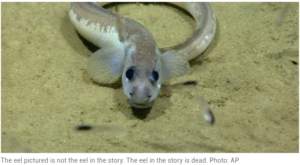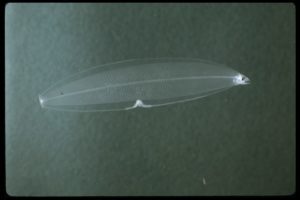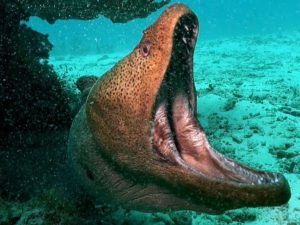Podcast: Play in new window | Download (Duration: 8:12 — 9.2MB)
Thanks to Joelle, Jacob, and Anna for their suggestions this week!
Further reading/watching:
Gulper Eel Balloons Its Massive Jaws
Watch rare footage of a shapeshifting eel with ‘remarkably full tummy’ swimming in the deep sea
The beautiful stellar jay:

The maybe not quite as beautiful but really awesome gulper eel (with its mouth full of water, image taken from first video linked above):
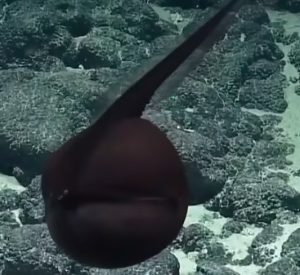
The same eel as above but with its mouth open so you can see just how big it is!
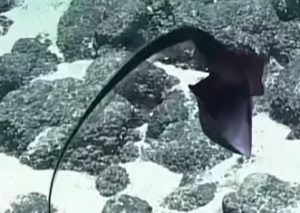
Show transcript:
Welcome to Strange Animals Podcast. I’m your host, Kate Shaw.
This week we’re going to learn about a bird suggested by Joelle, Jacob, and Anna, and a weird fish also suggested by Jacob.
Let’s start with the bird, the stellar jay, also called Steller’s jay! In the last few years there has been a push among bird enthusiasts to change the common names of birds named after people to names that are more general. While Steller’s jay hasn’t officially been renamed to the stellar jay, a lot of people are calling it that already so that’s what we’ll call it here. The word stellar means outstanding, and that’s definitely a good description of this bird.
The stellar jay is a beautiful bird that lives in western North America down into parts of Central America. It’s closely related to the blue jay found in eastern North America, and if you saw it from the middle down you might think it was a blue jay, except that it doesn’t have white markings on its tail and wings. It has a blue tail and wing feathers with dark bars, but from about the shoulders up it looks very different from the blue jay. It’s silvery-gray, brownish, or black on its head, neck, and back. Some populations have a white eyebrow marking that makes the bird look like it’s frowning. It has a crest like the blue jay, but its crest is bigger, spikier like it hasn’t brushed its hair yet, and the bird itself is bigger overall than its eastern cousin.
The stellar jay lives in forests, especially coniferous forests, where it eats pretty much anything it can find. It’s an omnivore that likes insects and other invertebrates, eggs and baby birds of other species, and even small animals like lizards and mice, but it also eats lots of nuts, berries, seeds, and other plant material. It will visit bird feeders, and especially likes sunflower seeds and raw peanuts.
The stellar jay is a corvid, distantly related to crows and magpies, and it shares the corvid trait of being intelligent, sometimes aggressive, and loud. It will imitate hawks in order to scare other birds away from food, and it will often chase smaller birds away from feeders. During nesting season, the birds get a lot quieter, and the male will sneak his way to and from the nest to feed his mate while she’s sitting on the eggs. The stellar jay prefers to build its nest in a conifer, either in a hollow in the trunk or on branches close to the trunk.
This is what the stellar jay sounds like:
[bird calls]
Jacob also suggested we learn about the gulper eel, which is sort of the opposite of the stellar jay. It’s a deep-sea fish with a lot of names, including pelican eel and my favorite, the umbrella-mouth. It’s black or sometimes dark brown and can grow up to about three feet long, or 90 cm. Much of its length consists of a long, whip-like tail.
The gulper eel’s mouth is ENORMOUS, ridiculously enormous, especially considering how slender the rest of the fish is. Its lower jaw is hinged and is extremely long, with a stretchy pouch of skin that forms its mouth and I guess you can call them cheeks. It is a very weird fish. Most of the time it keeps its jaw folded down against its sides, so that the jaws are barely visible and it looks more or less like a regular eelh. But when it wants to, the gulper eel can unfold its jaw and gulp in water to inflate its pouch, which makes it look like a black balloon with a tail. It sometimes does this if it feels threatened so that it looks bigger, but the huge jaws are actually for swallowing animals whole.
Not only can its mouth stretch to engulf animals bigger than the gulper eel is, its stomach can stretch just as much. It has tiny teeth, though, so it’s not likely that it would try to eat animals stronger than it is, because if it swallowed a big fish, that fish might thrash around inside the gulper eel and kill it. More often, the gulper eel’s stretchy mouth and stomach allow it to eat large groups of very small animals, mostly shrimp and other small crustaceans. It also helps it swallow squid and other soft-bodied animals that are larger than it is but not dangerous.
The gulper eel has a well-developed lateral line system, more properly called the octavolateralis system. All fish and some amphibians have this system, and in many species you can see it. It’s a line or a series of dots along the fish’s sides, and it’s actually a series of modified cells that are super sensitive to water motion. The lateral line system is what allows schools of fish to stay in formation while moving around as a group, and it also helps a fish know when a predator is approaching or when potential prey is nearby. It can even help the fish sense obstacles in the water that aren’t moving, like rocks. In the gulper eel, instead of the sensory cells being in a tiny canal under the skin, they’re on the surface to increase the amount of information the fish can gather from tiny water movements.
At the end of the tail, the gulper eel has a tiny organ called a caudal appendage, which is translucent. It has tiny tentacles and glows with a pinkish light, although it occasionally flashes red. Some researchers report that the lateral line also sometimes produces bioluminescence. The bioluminescence may lure small animals to the gulper eel the same way the anglerfish’s lure does. It’s possible that the gulper eel sometimes hangs in the deep water with its long tail curved up over its head, waiting for prey to approach, but for the most part it’s an active hunter of small crustaceans and other animals.
You may remember from other episodes that most deep-sea animals can’t see the color red. Some predatory fish, including a species of dragon fish, use that to their advantage by emitting red light that they can see but their prey can’t. It’s possible that the gulper eel’s tail emits red light to help it find groups of the tiny crustaceans it mostly eats. It has very small eyes and we don’t even know if it can see the color red or not. We also don’t know if its bioluminescent tail also gives off other light wavelengths that would act as a lure to small animals, or if it uses its caudal appendage to communicate with other gulper eels.
The gulper eel lives in many of the world’s oceans, especially in tropical areas, in depths up to 9,800 feet, or 3,000 meters. Sometimes it lives in shallower water too. Because it lives so deep most of the time, we don’t know a whole lot about it. Luckily, in the last few years scientists have learned a lot more about it from deep-sea rover observations.
You can find Strange Animals Podcast at strangeanimalspodcast.blubrry.net. That’s blueberry without any E’s. If you have questions, comments, or suggestions for future episodes, email us at strangeanimalspodcast@gmail.com. We also have a Patreon at patreon.com/strangeanimalspodcast if you’d like to support us for as little as one dollar a month and get monthly bonus episodes.
Thanks for listening!
